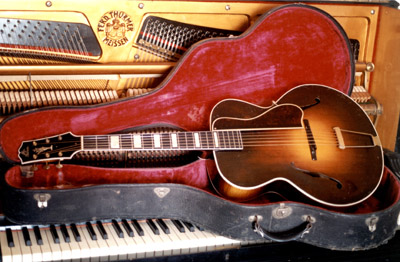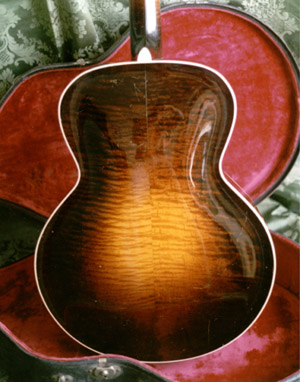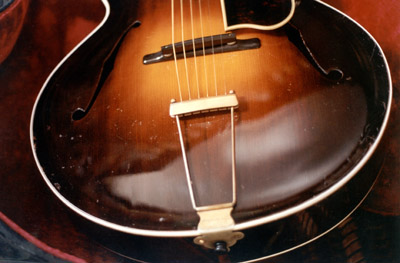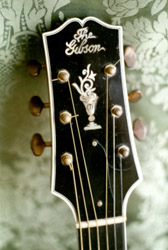
The Playmate of the Month
GIBSON L-5, 1930

This time we'll go back to the roots of modern guitar. We are in the early '20s, and the guitar holds a secondary place in american music: the small gut-string ‘parlour guitars’, with their smooth tone and low volume cannot be heard among the rumble of brass instruments in the hot-jazz era. The banjo, in spite of its tonal limits, at least can equal other instruments' volume, and is prefered as rhythm tool.
But other fretted instruments like mandolin, mandola, mando-cello reach a wide popularity, and give birth to many small ensembles. Around these instruments, experimentation proceeds fast: while Martin goes ahead on its traditional flat-top way, other manifacturers like Epiphone from New York, Gibson itself and Weymann & Son from Philadelphia contribute to the evolution of fretted instruments family
 |
Gibson, however, was the one who put the greatest effort in developing the mandolin family. There was an almost 'genetic' reason: Orville Gibson, even before Company's birth, had extended hand-carving technique, traditionally used in violin construction, to plectrum instruments, and so Gibson guitars, mandolins and mandolas all featured a typical arched-top shape. A new step ahead was due to Lloyd Loar, musician, inventor, acoustic engineer and so on: Loar realized that the arch-top construction alone was not enough to give a fretted instrument proper volume, and conceived many radical innovations, such as 'f' soundholes, the elevated fretboard which left the top more free to vibrate, and the new-style pickguard which was essential to give a support to the right hand of the player. It must be said, however, that in Loar's mind the guitar was just one of the members of the mandolin family, and certainly not the most important. |
|
The so conceived line of fretted instruments had its focus point in the F-5 mandolin (made famous by bluegrass artists like Bill Monroe); L-5 was the guitar of the group: body was sixteen-inch wide, top was spruce with parallel bracing, and maple or birch were used for back and sides. The neck was made of maple with a 24 ¾" ebony fretboard, dot inlays, pearl-button chrome tuners and trapeze tailpiece. The elevated pickguard was in celluloid, with no binding. L-5 was equipped with the new adjustable ‘truss-rod’ patented in 1921, with a simple bell-shaped black plastic cover. The headstock had the classic 'snake-head' shape with 'The Gibson' script logo and the 'torch' or pot decorative pearl inlay which has become the symbol of the model ever since. Inside of the body, in many cases, a second sound board was suspended to the top. This one was the so-called 'VirziTone Producer', patented by italian luthiers Virzi brothers from Palermo, Sicily, whose effectiveness gave rise to many doubts in everyone, except for Loar himself.. |
 |
WIth its austere simplicity, the new Gibson model already possessed all the innovating and genial elements which made of it the archetype of all the arch-top guitars. But success was not so immediate for Loar's creation: perhaps ahead of its times, the L-5 later proved to be the ideal instrument for a music that wasn't born yet: Big Band jazz. In the ’30s, when banjo's metallic sound showed too narrow boundaries for the creativity of jazz and dance ensemble musicians, f-hole archtop contibuted to the swing sound with loudness and tonal richness never heard before. But it wasn't only a great rhythm instrument, as proved by Eddie Lang and Lonnie Johnson incredible duets. And the small 16-inch L-5 also played an important role in country music, in the hands of Maybelle Carter, one of America's most idolized icons.
|
Through the years, the model went through many changes both in its look and in its structure: large pearloid position-markers, gold-plated hardware and richer binding, and most notably the 'advanced' size of the body (17-inch) with a larger headstock design: this new advanced L-5 also featured a bigger and heavier tailpiece, and a longer 25 ½" scale. L-5 Premier (cutaway) was then introduced in 1939, and in the same year a 'natural finish' began to be offered in Gibson catalogs. These innovations marked a definitive step ahead, towards a 'modern' instrument conceived to deliver an even louder volume, and to offer to the player the whole neck lenght for solo work. From this point of view, it really was a prelude to the electric L-5 CES introduced in 1951, which stands out until today as the symbol itself of Gibson quality.
|
 |
|
The guitar you see here was built in 1930, when the ebony fretboard with large pearloid blocks had lost its pointed end. The headstock still shows a 'snakehead' shape, with ‘The Gibson’ script logo, which would have... lost its article the following year. The neck has a very distinctive V-shape, and is made of two pieces of flamed maple, and the same wood is used for sides and gorgeous back. Spruce top shows a very fine sunburst finish, and many details, such as ebony bridge or gold-plated trapeze tailpiece, are of light construction and subtle elegance. Tuners are the classic early Grover Sta-Tites, also used by D’Angelico, and after 70 years are still working great. Yes, because this 16" L-5, far from being a museum-piece, is a very playable instrument with an easy action, with comfortable dimentions and a very balanced voice, well-suited for a recording studio. Personally, I have been surprised by its excellence in finger-picking styles, especially country blues, which seems to find again in acoustic L-5's ancient woods warm and enthusiastic support, maybe generated by their common and venerable age. |
 |